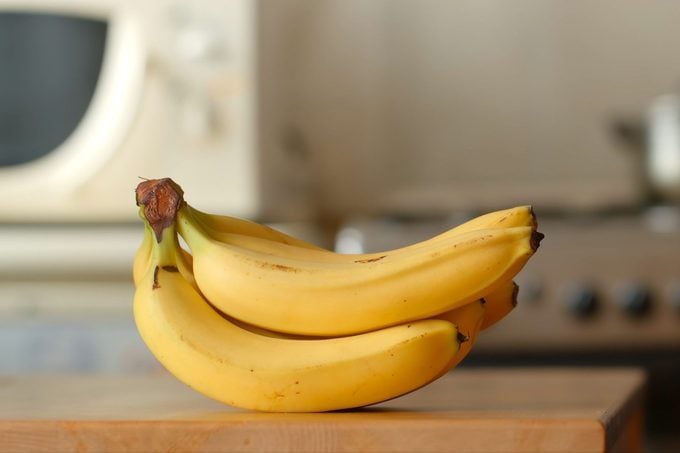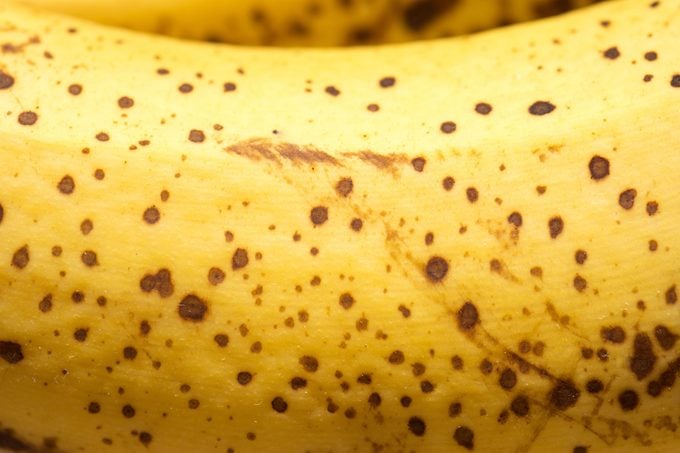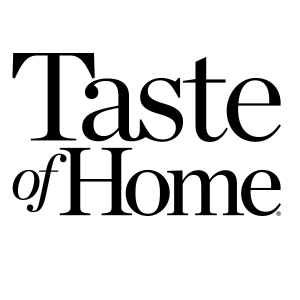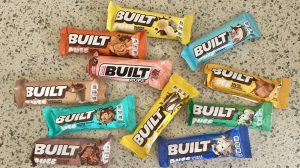
Banana basics
Bananas are delicious, portable, nutritious and conveniently come with their own all-natural wrapper, so it makes sense that they are the most consumed fruit in the United States according to 2021 data from Statista.
Here’s the lowdown on this tropical fruit’s nutritional value, and healthful ways to incorporate ‘nanners into your regular eating routine.
Get The Healthy @Reader’s Digest newsletter

Banana nutrition facts
A medium banana (about seven inches long) provides the following nutrients:
- Calories: 105
- Protein: 1.29 grams
- Fat: 0.389 grams
- Carbohydrates: 26.9 grams
- Fiber: 3.07 grams
- Sugar: 14.4 grams
- Vitamin B6: 0.43 mg (22% of the Daily Value)
- Vitamin C: 10.3 mg (17% of the Daily Value)
- Potassium: 422 mg (12% of the Daily Value)
- Magnesium: 31.9 mg (8% of the Daily Value)
- Manganese: 0.319 mg (16% of the Daily Value)
- Water: About 3 ounces
Bananas are lower in calories and sugar than many people think, and as you can see, the 14 grams of sugar come with several vital nutrients.
In addition, even the strictest guidelines on sugar from the World Health Organization (WHO) and the American Heart Association (AHA) only advise limiting added sugar, or free sugar, not naturally occurring sugar from fresh, whole fruit.
People often wonder about how many calories are in a banana. In a medium banana, there are about 100 calories. But remember—a banana’s calorie content depends on its size, so that can vary.
How the Calorie Content in Food Is Determined
Banana benefits
Potassium
Bananas are widely known for their high potassium content, and for good reason. This key mineral alone offers important benefits.
Potassium is a type of electrolyte that supports a regular heartbeat, and allows nerves to function and muscles to contract. It also helps move nutrients into cells and transfer waste out of cells.
In addition, a potassium-rich diet helps to regulate blood pressure by offsetting some of sodium’s harmful effects. The nutrient acts like a natural diuretic, to sweep excess sodium and fluid out of the body, and counter water retention.
6 Signs You’re Not Getting Enough Potassium
Antioxidants
Bananas are also rich in polyphenolic substances that contain antioxidant properties known to counter inflammation and cell damage, which can be the cause of many disorders. That includes arthritis, diabetes, artery hardening, age-related macular degeneration, certain types of cancer and Alzheimer’s disease, according to a 2018 study in Food Quality and Safety.
This effect is also backed by a 2020 study published in the journal Molecules, which states that bioactive compounds in bananas fend off oxidative damage in the body. In a nutshell, oxidative damage occurs when there is an imbalance between the production of cell-damaging free radicals and the body’s ability to counter their harmful effects. That means the protective compounds in bananas help prevent genetic damage or DNA compromise, lower disease risk and enhance neurological functioning.
Drinking This Beloved Juice Every Day Could Reduce Your Heart Disease Risk
Other nutrients
Green or unripe bananas also provide resistant starch, a unique kind of carbohydrate, according to the journal Heliyon. Like fiber, resistant starch isn’t digestible or absorbable into the bloodstream.
When it reaches the large intestine it gets fermented, which triggers the body to increase fat burning, and may play a role in preventing colorectal cancer, per Critical Reviews in Food Science and Nutrition and the Journal of Food Science and Technology.
Another natural substance found in bananas called fructooligosaccharides serve as prebiotics, according to the Journal of Agricultural and Food Chemistry. Prebiotics enhance the body’s ability to absorb calcium and feed “good” probiotic bacteria, to support digestive health and immune function.
11 Foods with More Calcium Than a Glass of Milk
Energy
Bananas are also a good mood food. The fruit has been found to contain serotonin, which supports feelings of wellbeing, as well as dopamine, according to research published in Food Chemistry.
Bananas are also one of the best foods both for sustained energy, as their fiber and vitamin B6 help regulate blood sugar and insulin levels, per the International Journal of Molecular Sciences.
Finally, bananas make an excellent pre-workout snack to fuel exercise performance. As a board-certified sports dietitian, I often advise my clients to eat a banana about 30 minutes before starting training sessions.
Research in the Journal of Proteome Research found the fruit can also be consumed during exercise to power endurance.
What Top Fitness Instructors Really Eat to Refuel Post Workout

Other banana products and uses
Banana peels
In addition to their flesh or pulp, other components of the banana plant are also edible, including the peel, which reduces waste and improves the environmental sustainability of this staple food.
People typically throw out the peels, but studies have found that banana peels are even higher in antioxidants than their pulp. Banana flour, made from pulp and peel in various stages of ripeness, is now thought to be a functional food, which also provides resistant starch, says 2019 research, published in Journal of Food Science and Technology.
Banana flour
A 2019 systematic review published in the journal Nutrients looked at data on the benefits of green banana flour consumption. Researchers concluded eating green banana flour is linked to improvements in gastrointestinal symptoms and diseases, insulin metabolism, weight control, and kidney and liver complications associated with diabetes.
Banana flour is also easy to incorporate into savory dishes, including pasta. Due to its higher starch content, a good rule of thumb is to use a three-quarters cup to replace every one cup of all purpose flour.
5 Delicious Almond Flour Recipes
Banana milk
Another relatively new banana product on the market is banana milk, a mix of filtered water, bananas and sunflower oil.
One cup of Mooala Organic Bananamilk ($30 per 6 pack) with no added sugar provides 25% of the Daily Value for calcium, 15% for copper, and 8% for potassium, vitamin B6 and magnesium.
As for banana milk uses, whip it into smoothies, add to coffee, or use as the liquid in anything from homemade popsicles to cocktails.
What You Need to Know About Plant-Based Milk
Ways to enjoy bananas and banana products
Bananas are wonderful as is, but they can also be incorporated into a variety of recipes. At breakfast time, blend bananas into smoothies, or add to cereal, oatmeal, or overnight oats, pancakes, acai bowls, or chia pudding.
Fold spices like ginger and cinnamon into pureed banana to enjoy as a treat, freeze as an ice cream alternative, or used to add moisture and nutrients to baked good recipes.
Dip whole or sliced bananas into melted dark chocolate—with or without rolling in minced nuts or seeds—and freeze as a healthy treat.
Bananas are also traditionally incorporated into a variety of desserts, including banana pudding, cake, pie, and banana splits.
To upgrade nutrients, make better-for-you versions with alternative flours, including those sourced from green banana, chickpeas, and almonds, and try plant-based ice creams for your split, made from oat, coconut, or nut milks.
Bottom line: any way you slice them, bananas are good for you; and they don’t deserve a bad reputation due to concerns about calories or sugar.
Enjoy bananas solo, or build into meals, snacks, and drinks, and reap the benefits of their flavor, nutrients, and potential health benefits.
For more wellness updates, follow The Healthy on Facebook, Instagram, and Twitter. Keep reading:
link







